The American People Will Not Benefit From Ranked Choice Voting
Key Takeaways
Ranked Choice Voting is an overly complicated system that is not popular among the vast majority of Americans.
Under Ranked Choice Voting, the voter does not have the ability to explicitly say who they would like to win compared to the other candidates.
Instead of making it easier to vote and harder to cheat, Ranked Choice Voting will confuse voters and discourage more citizens from voting.
Ranked Choice Voting: What Is It?
Ranked Choice Voting is an elections system in which voters can vote for multiple candidates ranking the candidates in order of preference. If any candidate wins a simple majority of first-preference votes (50% plus one vote), he or she is declared the winner. If no candidate wins a simple majority of first-preference votes, an algorithm—rather than a run-off election or simple plurality winner elections—determines the ultimate winner. Specifically, with Ranked Choice Voting, the candidate who receives the least votes is removed from the race, and any ballots on which that candidate was marked as a first-preference are recounted with the second-preference marking, moving into the first-preference spot. This process continues until one candidate receives the simple majority of the ballots. Unlike an actual run-off system, candidates are not able to retool their campaigns as the pool of contenders shrinks, and voters are never given the opportunity to reassess the pool and actively affirm their top preference (Ballotpedia, 2019).
Research Shows Ranked Choice Voting Has Negative Effects on Elections
An article written by FairVote—a left-leaning nonprofit that advocates for Ranked Choice Voting—and published in the National Civic Review in late 2019, claims that it minimizes the political furor surrounding elections by incentivizing candidates to appeal to a broader electorate in the pursuit of second-preference votes (Lavin, 2019). The article also denies that the system is complicated. However, the facts show just the opposite.
Currently, the states of Maine and Alaska utilize Ranked Choice Voting. In both states, elections remain contentious. A Massachusetts Institute of Technology study on Ranked Choice Voting in Maine revealed that it “produced significantly lower levels of voter confidence, voter satisfaction, and ease of use. It also increased the perception that the voting process was slanted against the respondent’s party. Similarly, [the study] found that it increased the amount of time it took to vote by nearly 12 seconds per candidate than voting using a plurality ballot” (Clark, 2021). The study also found that negative campaign ad spending increased after implementation of Ranked Choice Voting, in contrast to the claim that it increases civility in campaigning.
Ranked Choice Voting Disenfranchises Voters
The principle behind the democratic process of casting a vote is that each person has the right to equal and proportionate representation in government. Leaders are chosen by voters, comparing the candidates against each other and casting a ballot. If there are going to be multiple rounds of casting ballots, each voter should be able to weigh in actively and vote once in each of those rounds, and candidates should be allowed to continue campaigning after anybody drops out. Campaign strategies, media attention, and voter perceptions are bound to change anytime the field of candidates is shaken up; running a simulated algorithm is not a substitute for this important democratic process. Ranked Choice Voting prohibits a voter from knowing which candidates remain in subsequent rounds and therefore makes it impossible for voters to be able to reassess the field accurately and consistently. Under Ranked Choice Voting, the voter does not have the ability to explicitly say who they would like to win compared to the other candidates because they do not know until after their only ballot is cast which candidates will be eliminated and which will remain.
Additionally, implementing Ranked Choice Voting prolongs the elections process. States and counties already struggle to deliver election results within a reasonable timeframe, and this contributes to the lack of public trust in elections currently. Ranked Choice Voting adds in several more rounds of tabulating ballots, leading to longer waiting periods before election results are announced, and opening the door for more errors in the tabulation process, while placing even greater a strain on the election workers and poll watchers.
A Majority of Americans Do Not Approve of Ranked Choice Voting
When recently polled, Americans reinforce what we already know from real-time experience. A new Rasmussen poll shows that 42% of respondents had never heard of Ranked Choice Voting. Once the concept was explained, 60% of those polled did not agree with Ranked Choice Voting and only 23% agreed with it. And when the possibility that one candidate could have received the most first-preference votes in the election but that another candidate could win the election with the second-preference votes, 8% of Americans viewed Ranked Choice Voting as very favorable.
The American people will not benefit from policies that implement Ranked Choice Voting. The effects will only confuse and discourage citizens, which is not in line with the Center for Election Integrity’s mission of making it easy to vote and hard to cheat.
Mike Vallante is the Director of the Center for Election Integrity at the America First Policy Institute.
Works Cited
